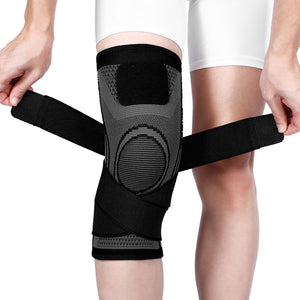Why Do the Knees Need Support?

This article examines the requirement for support for the knees. We'll go over typical knee problems and injuries and why it's so important to provide your knees with the support they need. We will also talk about other variables that can strain the knees, like age, weight, and degree of activity. Finally, we will discuss the advantages of utilizing knee supports and offer advice on how to choose and apply them.
fivalifitness.com
The Structure of the Knee
The knee joint is a complicated hinge joint that connects the femur (thigh bone) to the tibia (shin bone) and the patella (kneecap). It is essential for maintaining stability, enabling mobility, and bearing body weight. The knee's structure can be broken down into multiple parts:
- Bones: The femur, tibia, and patella are the three bones that make up the knee joint. The patella rests in front of the knee and offers protection, while the rounded ends of the femur and tibia make up the primary articulating surfaces of the knee joint.
- Articular cartilage: Articular cartilage is a smooth, slippery substance that covers the ends of the femur, tibia, and back of the patella. During movement, this cartilage serves to lessen friction and absorb stress.
- Meniscus: Menisci (plural: meniscus) are two C-shaped sections of cartilage that make up the knee joint. They help to disperse forces over the knee joint and serve as shock absorbers. They offer support and padding as well.
- Ligaments: There are four main ligaments that support the knee joint. Within the knee joint, the anterior cruciate ligament (ACL) and posterior cruciate ligament (PCL) cross each other to help prevent the tibia from moving forward or backward in relation to the femur. Stability on the inside and outside of the knee is provided by the lateral collateral ligament (LCL) and medial collateral ligament (MCL), respectively.
- Tendons and muscles: The stability and mobility of the knee joint are facilitated by a number of surrounding muscles. The hamstring muscles are located in the rear of the thigh, and the quadriceps muscles are located at the front of the thigh. Coordination of movement is made possible by the tendon connecting these muscles to the bones.
- Synovial fluid and joint capsule: The robust, fibrous joint capsule that surrounds the knee joint contributes to the stability of the joint. Synovial fluid is produced by the inner lining of the joint capsule and nourishes the cartilage while lubricating the joint.
Maintaining the knee's health, avoiding injuries, and receiving the right care when needed all depend on an understanding of its structure.
Factors
Several factors can stress the knees and increase the risk of knee problems and injuries. Among these are:
- Weight: Carrying too much weight on one's knees strains them more. Walking, running, and even standing for long periods put additional strain on the knees with every extra pound.
- Age: Our knees' natural cartilage deteriorates as we age, leaving them more vulnerable to strain and damage. Additionally, the tendons and ligaments become less pliable and more vulnerable to tension.
- Weak Muscles: An unstable knee joint can result from weak muscles, especially in the thighs and hips. Unbalanced pressure and greater joint stress might arise from weak surrounding muscles that cannot adequately support the knee.
- Overuse and Repetitive Motion: Excessive strain on the knees can result from repetitive motion or overuse without adequate rest and recuperation. This is frequently observed in sportsmen or those who engage in repetitive jumping, squatting, or kneeling.
- Poor Form or Technique: When engaging in physical activity like lifting large objects, jumping, or making abrupt direction changes, poor body mechanics can cause knee strain and raise the risk of injury.
- Past Injuries: A history of meniscus damage or ligament rips can weaken the knee joint and increase its vulnerability to stress and recurrence.
It's critical to keep these things in mind and take the necessary precautions to lessen knee stress. This can entail keeping a healthy weight, working out frequently to build strength and flexibility, doing physical activities with the right form, and giving your knees enough time to rest and heal.
Types of Knee Support
- Knee Braces: Knee braces are external supports made to give the knee joint stability and defense. Prophylactic braces are used to prevent injuries; functional braces are used to provide support during physical activity; and rehabilitative braces are used to aid in the healing process following an accident. These braces can be tailored to match individual demands and unique knee ailments. They are usually composed of materials like neoprene, elastic, or stiff supports.
- Knee taping: Knee taping is putting adhesive tape on the knee joint to restrict its range of motion and offer external support. This method is applied to manage current injuries, promote the healing process, and help prevent future injuries. When used correctly, knee tape can help stabilize the knee and lessen the chance of doing specific activities that could make an injury worse.
- Orthotic Inserts: Although they don't directly support the knee, orthotic inserts, also known as insoles, are essential for giving the foot and lower limbs support and alignment. Through the treatment of conditions like overpronation or disparities in leg length, orthotic inserts can substantially enhance knee stability and alignment.
These various kinds of knee supports have diverse functions and provide differing levels of support for treating and avoiding knee ailments and accidents.
fivalifitness.com
*Disclaimer
The information provided in articles written by Fivali is intended for educational and reference purposes only. The content on this website (www.fivalifitness.com) is not intended to diagnose, treat, cure, or prevent any disease. We do not recommend self-diagnosis or self-treatment based on the information provided in our articles. Always consult a qualified healthcare professional if you have any concerns about your health or well-being.
If you are experiencing any symptoms or discomfort, we strongly encourage you to seek medical attention from a qualified healthcare professional. Only a licensed healthcare practitioner can provide an accurate diagnosis and appropriate treatment plan tailored to your individual needs.
-
Posted in
Brace, Healthy Lifestyle, sports













